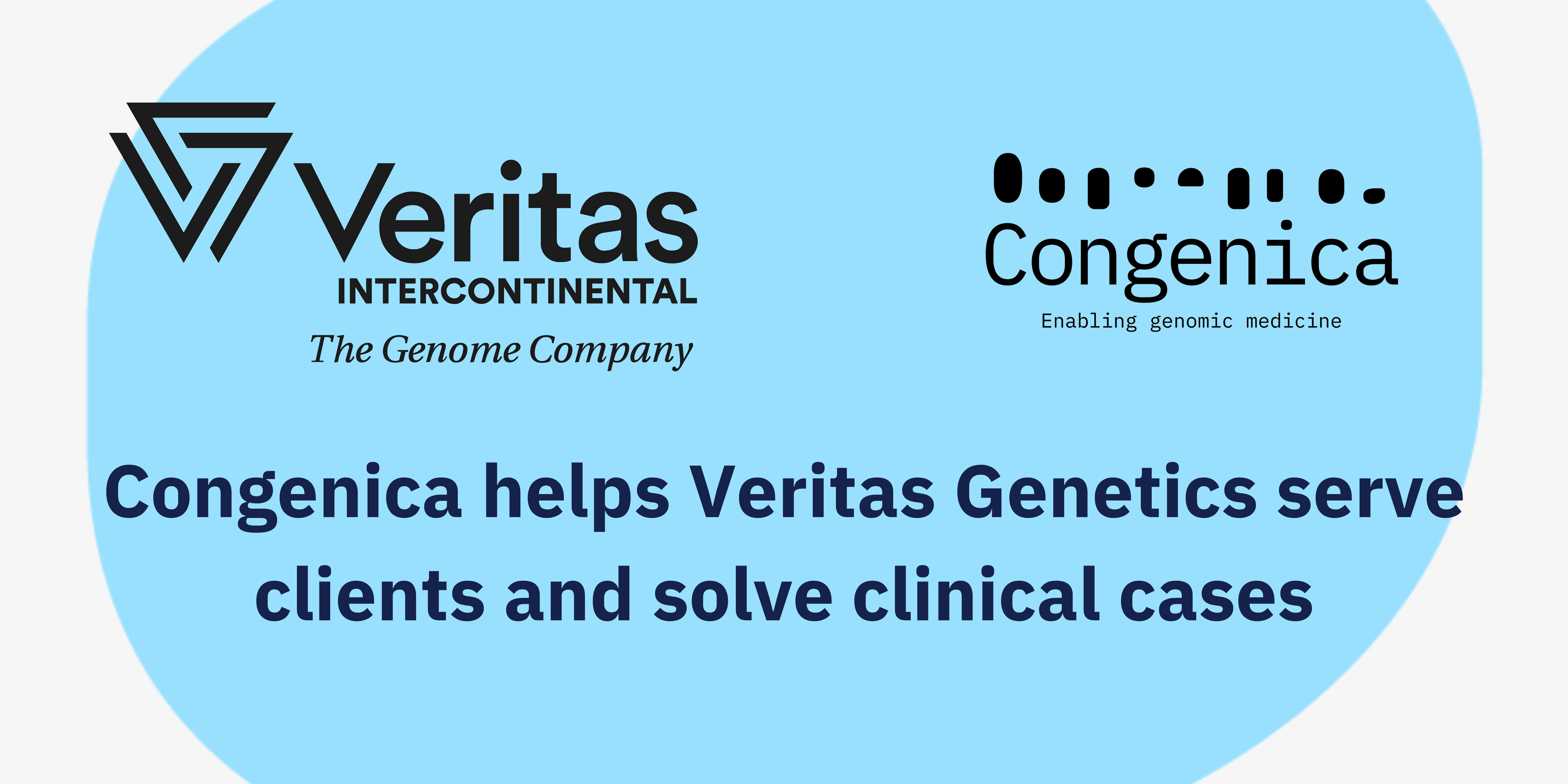How Congenica NGS data analysis software is helping Veritas Intercontinental serve its clients and solve more cases
Case studies originally presented by Dr. Miriam León Otegui, Head of Clinical Analysis & Curation, Veritas Genetics at Enabling Genomic Medicine 2020
Veritas Intercontinental – a leading personal genomics company – has partnered with Congenica for the analysis of NGS data to improve diagnostic yield and increasing the efficiency, throughput and speed of analysis in our diagnostic laboratory and providing huge benefits for patients.
In 2018, Veritas Intercontinental opened its headquarters in Madrid where business is centralized for Europe, Latin America and the United Arab Emirates. Up to this point, clinical genetics was only used as a diagnostic tool for patients with symptoms. Veritas was the first company to sequence healthy patients and enter the field of predictive medicine.
The company offers genetic testing, interpretation and genetic counseling services to consumers and physicians, as well as data storage and management services to medical researchers. In this blog post, we’ll be looking at the impact the partnership has had on three clinical cases.
Automatically identifying the causative genomic variant to provide answers for a 17-year-old patient with suspected Stickler syndrome
Congenica NGS data analysis software was used to analyze a 17-year old female patient with suspected Stickler Syndrome and a history of conductive hearing loss, progressive high-grade myopia, osteoarthritis, polydactyly resection of the right foot, and photocoagulation of the right eye due to retinal detachment. In this case the parental samples were available, so we performed a whole-exome-sequencing in trio. We entered the appropriate HPO terms determined by our medical team and decided to upload a skeletal dysplasia gene panel (546 genes).
A De novo heterozygous variant in the splice region in the COL11A1 gene was automatically identified as the leading causative variant by Congenica’s Exomiser variant prioritization tool. Pathogenic variants in the COL11A1 gene are related to Stickler syndrome type 2 or Marshall syndrome (two allelic disorders that share a highly similar clinical spectrum). Marshall / Stickler syndrome has been described to be caused primarily by exon skipping mutations in COL11A1. 20 out of 27 pathogenic variants described up to date in COL11A1 are of the splicing type.
With published literature reviewed in the Congenica software we could confidently determine a likely pathogenic variant that can explain the patient's phenotype and provide a rapid answer that previously might not have been possible.
Rapid variant detection supports diagnosis for 15-year-old patient with a history of developmental delay
In this case we used Congenica NGS data analysis software to analyze a 15-year-old male patient with a moderate cognitive deficit, a history of developmental delay and late acquisition of language. The patient had a learning disorder at the beginning of schooling and is in a special education school, with no current literacy achievement. He presents facial and hand dysmorphic features and a cutaneous syndactyly of first and second toes.
Genetic testing performed previously showed an expected 46 XY karyotype, 750k CGH array and metabolic screening and the patient has a sister with the same phenotype. We also had the parental samples so we could perform a whole exome sequencing trio analysis. We introduced HPO terms on intellectual disability and imported another gene panel with intellectual disability. Congenica automatically ranked a list of likely causative variants in order of relevance and a heterozygous variant was instantly detected in the ZBTB18 gene, maternally inherited but present in mosaicism. Variants in ZBTB18 have been related to Mental retardation, autosomal dominant 22 as part of the 1q43-q44 microdeletion syndrome.
By automatically identifying the likely causative variant, Congenica saved many hours of manual interpretation time allowing us to provide actionable insights of immense value for the patient.
Solving a life-long search for the cause of 59-year-old patient’s condition
A 59-year-old male patient with consanguineous parents and a long-standing clinical picture with legal blindness since the age of 16 when he was diagnosed with cataracts and high-grade myopia and he also presents microcephaly. His four siblings are all visually impaired, one of them legally blind. We added our HPO terms in Congenica and uploaded imported gene panels: cataracts (102 genes), retinal disorders (261 genes), and severe microcephaly (101 genes).
Congenica produced a list of variants, with a homozygous truncating variant detected in the CDHR1 gene ranked in the 1st position. Variants in CDHR1 have been related to rod and cone dystrophy 15 and retinosis pigmentosa 65, both with an autosomal recessive inheritance pattern. Most of the disease-causing variants described in CDHR1 are truncating mutations.
Published literature was highlighted within the Congenica software and we were quickly able to determine a likely pathogenic variant that explains the patient's phenotype allowing for more effective clinical intervention.
Enabling NGS analysis at scale to quickly solve clinical cases
The Congenica platform has enabled Veritas to quickly scale up from panel analysis to whole exome and whole genome analysis without requiring additional resources or infrastructure.
Using Congenica, Veritas has also been able to automate many aspects of its NGS analysis workflow to rapidly solve clinical cases, improving diagnostic yield and providing value for patients and healthcare providers.
To learn more about how Congenica is helping Veritas Intercontinental solve their challenges and analyze clinical cases download our full case study.


.png?width=320&height=192&name=Untitled%20design%20(8).png)
.png?width=320&height=192&name=Since%202016%2c%20the%20number%20of%20women%20working%20in%20STEM%20fields%20in%20the%20UK%20has%20increased%20by%20216%2c552%2c%20taking%20the%20total%20number%20over%20the%201%20million%20mark%20for%20the%20first%20time.%20Women%20now%20make%20up%2024%25%20of%20the%20STEM%20workforce%20i%20(2).png)
-1.png?width=320&height=192&name=Deciphering%20Developmental%20Disorders%20(1)-1.png)